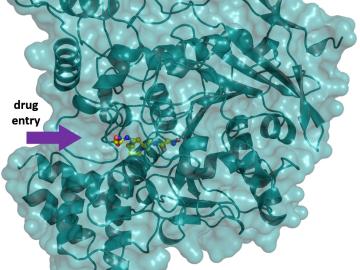
Filter News
Area of Research
- Biology and Environment (10)
- Clean Energy (41)
- Climate and Environmental Systems (2)
- Computer Science (1)
- Energy Sciences (1)
- Fusion and Fission (4)
- Fusion Energy (5)
- Isotopes (3)
- Materials (26)
- Materials for Computing (2)
- National Security (8)
- Neutron Science (11)
- Nuclear Science and Technology (15)
- Nuclear Systems Modeling, Simulation and Validation (2)
- Quantum information Science (2)
- Supercomputing (22)
News Type
Date
News Topics
- 3-D Printing/Advanced Manufacturing (13)
- Advanced Reactors (10)
- Artificial Intelligence (6)
- Big Data (9)
- Bioenergy (6)
- Biology (4)
- Biomedical (16)
- Biotechnology (1)
- Chemical Sciences (2)
- Clean Water (2)
- Climate Change (5)
- Computer Science (26)
- Coronavirus (14)
- Cybersecurity (2)
- Energy Storage (14)
- Environment (16)
- Exascale Computing (2)
- Frontier (1)
- Fusion (12)
- Grid (6)
- High-Performance Computing (1)
- Isotopes (4)
- Machine Learning (5)
- Materials Science (19)
- Mathematics (2)
- Mercury (1)
- Microscopy (5)
- Molten Salt (1)
- Nanotechnology (5)
- Neutron Science (13)
- Nuclear Energy (23)
- Physics (8)
- Polymers (3)
- Quantum Science (6)
- Security (2)
- Space Exploration (1)
- Summit (10)
- Sustainable Energy (12)
- Transformational Challenge Reactor (3)
- Transportation (9)
Media Contacts

Ilias Belharouak is leading ORNL’s research efforts in investigating new materials for solid-state batteries, which can double the charging capacity of lithium-ion batteries, commonly used today for electronic devices such as cell phones.

A software package, 10 years in the making, that can predict the behavior of nuclear reactors’ cores with stunning accuracy has been licensed commercially for the first time.

Hydropower developers must consider many factors when it comes time to license a new project or renew an existing one: How can environmental impacts be mitigated, including to fish populations?

The techniques Theodore Biewer and his colleagues are using to measure whether plasma has the right conditions to create fusion have been around awhile.

“Engineering is about building things to help others.” Before diving into a longer explanation, that’s how Singanallur “Venkat” Venkatakrishnan, an electrical and computer engineer ORNL, described engineering to students at Northwest Middle School.

In the most comprehensive, structure-based approach to date, a team of scientists may have discovered a new family of antidotes for certain poisons that can mitigate their effects more efficiently compared with existing remedies.

Large trucks lumbering through congested cities could become more fuel efficient simply by not having to stop at so many traffic lights.

Oak Ridge National Laboratory researchers have developed a modeling tool that identifies cost-effective energy efficiency opportunities in existing buildings across the United States.

Joe Paddison, a Eugene P. Wigner Fellow at the Department of Energy’s Oak Ridge National Laboratory, believes there’s more information to be found in neutron scattering data than scientists like himself might expect.

Biological membranes, such as the “walls” of most types of living cells, primarily consist of a double layer of lipids, or “lipid bilayer,” that forms the structure, and a variety of embedded and attached proteins with highly specialized functions, including proteins that rapidly and selectively transport ions and molecules in and out of the cell.


